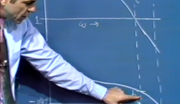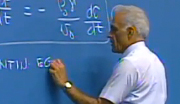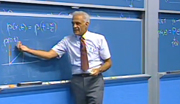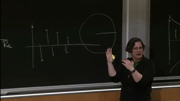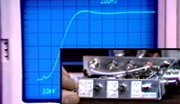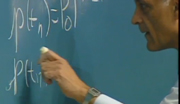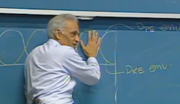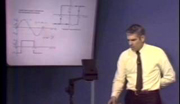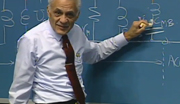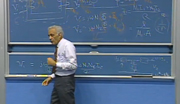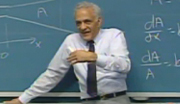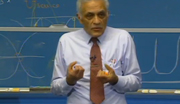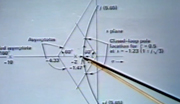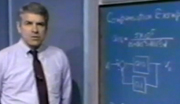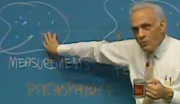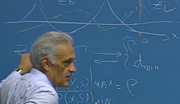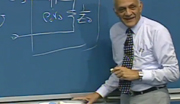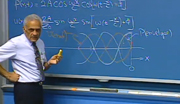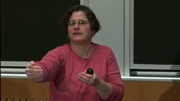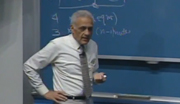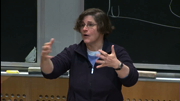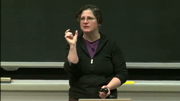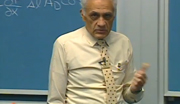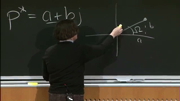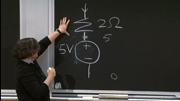Amar Bose: 6.312 Lecture 26
DR. AMAR G. BOSE: This morning we have one topic, I think, that was on the list of the randomly selected topics of psychoacoustics that had bearing upon sound reproduction that we didn't cover-- distortion. Remember, I've told you several times that the hardest thing to do in the psychophysics experiments is to keep all the variables that you don't want constant, that you're not studying, and let only one change. Like, if you're trying to find out how bumpy a car is to people, you have to watch out that when you change the bumpiness, the acceleration, that you don't change the noise, because now you'll be getting a reaction that isn't toward the thing that you want. So that's a very difficult thing.
Distortion is an example. It's used in the field extremely loosely. Musicians sometimes use it to mean anything that deviates from what they think is right, be it linear, meaning frequency response, or nonlinear things.
Normally in engineering, you think of distortion as something that arises from nonlinearities. And as such, distortion is amplitude dependent. And so you can't give a person, let's say, two samples of music and say is this sample distorted from that? Because then you are presuming some sort of ability in the person to know that distortion sounds different than an aberration in frequency response, for example.
But there's a way of telling if there's amplitude dependent changes in the music. And the way you can do that is very simple. Namely, you take your device that you have under test, you feed the signal through it first through a big attenuator. And then you come out through another one. By attenuator, I mean that you could have gain also.
So almost all the-- that's not true. I already thought of one that isn't true for. But most of the forms of distortion increase with increasing amplitude. There's one that if you have a transfer function of an active device, solid state device, for example-- and there's a little crossover, an amplifier made of this. And there's a crossover distortion with a little blank spot as you go across 0. That's not going to increase with amplitude. But you can investigate that by making a similar kind of thing.
But basically what you would do is you would set this level to some minus 20 or let's say minus 30 dB, then minus 20, then minus 10. Then means in the next experiment. Then 0, et cetera. And then this one goes in the reverse order. This would go 0. Let's see, these were going less attenuation. So you want gain here. And then you want minus 10, minus 20, minus 30, et cetera here.
And then you can bring this thing out if it happens to be sound and put it through headphones or whatever to get out the ambient sound. This might be a tape recorder. It might be an amplifier. It might be anything.
And what you do is you play a section through in which the input here is very low. But you're hearing it at a reference level. Then you crank up the input, crank down the output. Frequency response, everything else hasn't changed with these pads. And you do it again. And you make an AX test between the lowest input one and the next one. And then you make an AX test-- between the outputs, obviously-- between the lowest and this, lowest and this, lowest and so and so.
And then you can find out how high an input you have to go to here before a person-- remember in the AX test, you can only ask them not what you like best, but is there a difference, yes or no? And then you can find out at what level input you have to go to before the person can say there's a difference between the output with the lowest input and the current output. But the important thing is that each one that he hears has to be at the same volume.
So if you have any hi-fi friends who are saying listen to distortion, in anything but the most gross cases where you're overloading the whole system and the cone is flopping or the amplifier's clipping, you won't really be able to say much about distortion. So again, constructing of psychoacoustic experiments, I would say-- or psychophysic experiments-- are more difficult in some dimensions than a lot of the other things we do in the laboratory or in engineering. It takes a great deal of skill and a great deal of care.
And historically, up through the '60s, there was very loose work in this area except at a few places like Bell Telephone laboratories. And so there were a lot of things written that were very soft. But with time, that got refined. And today, it's a very respectable field indeed. So again, just an example of the kind of care you have to take.
Let's see, I think I'll put something else in here. By the way, again, congratulations to you. Even though the quiz turned out to be too long, you did fantastically well. I'm very happy. Let's see.
Acoustic wave, I think I'll stick in another thing here that you will see Friday-- will they see the headphones and active noise? OK. I'll tell you a little bit about the process, if you wish, of invention, because you can't teach it. And so if more people just review with you the kind of thoughts that go through their heads when they develop different things, when you first start developing something, you won't think, jeez, I'm on the floor crawling around looking for the light, or something. You'll realize that some of the thought processes you go through are right, the kind of things you're going to have to go through, that you don't go from A to B, zip, like that.
So I'll try to review a couple of things with you just so that you understand that thought process and when you get into it one time you don't think that you're going on a wild goose chase, even though you might be. But research is, at least, by my definition, only research when you don't know if it's possible. It then becomes engineering when it's possible. So you are scrambling in the dark, and I'll try to explain that process somewhat. And we'll talk more about it on the Friday, namely, how do you get that process going? But for now, we'll review just a couple of things that have to do with acoustics but have to do, more importantly, with the thought process that causes these things.
First one is the active noise cancellation. What you're going to find out that maybe you are not aware of now-- I don't think I was aware of it when I sat in your chairs-- is that you won't plan to make an invention. You won't say, well, I'm going to sit down now. I'm going to make an invention of such and such. It doesn't happen that way.
Your mind gets going on something that you would like to see happen. And then it starts working on that. And then you start getting ideas.
Now, this particular first one I'll describe to you, which is active noise cancellation, and you're going to experience it, namely a headset, circumoral, you put it on and you then turn a button, a switch, and the active part comes in, and it pushes the noise way down. In fact, so far that it beats all the military systems that are just for noise cancellation, not for communication. In other words, they have tremendous ones, and they have tremendous ones, big heavy ones, for a reason. The government currently pays more than $200 million a year in hearing disabilities to ex-servicemen, hearing disabilities that were incurred in the service.
In helicopters, particularly, tank, even in airplane aircraft. It's my understanding that in commercial aircraft, the second most common reason for early retirement is loss of hearing, even in commercial planes. But in the military planes, it's much worse. And in helicopters, it's brutal. And in tank vehicles, tread vehicles, the sound level's terrible. So the military has a lot of these very heavy things. But with this active concept, you go down below any of them.
Now, we didn't set out to say, oh, we're going to design-- the thought wouldn't even have occurred, I don't think, in active noise cancellation. You know that to get rid of base, it usually takes mass. Because if I have a wall here and somebody's making noise in the other room, the only reason the noise gets in here, assuming there are no holes or anything, is that this wall stars vibrating.
And of course, at high frequencies, it's very hard to get that thing vibrating. And so you don't hear if your neighbor has a hi-fi, what you hear is boom, boom, boom all the time. You don't hear the highs. Because it's the boom, boom, boom that get's the wall shaking. And then it radiates sound into the room.
So you normally think, OK, put a lot of mass in there. And so the headset won't shake. And it's so thick that it won't vibrate on your ears. And that's what people have done. But there's a limit to what you can do.
Well, how this particular thing came about was one day, I was flying on Swiss Air from Zurich to Boston. And they had just introduced these-- they just go on the pin, the little pads, the typical soft pad, open cell foam electric headsets, which replaced these unbelievable tubes that went into the ear.
And so I saw that and I thought, oh my god, this is going to be a great journey. Because they have good classical music that I happen to like and whatnot coming out of the armrest. So I was really excited about it. The plane took off. I put these things on.
I couldn't believe it. First of all, those tubes, the ones with the little cup on the end that you shove into your ear, turns out they block a reasonable amount of the ambient noise. What they let through in terms of music leaves something to be desired. But basically, at least you didn't hear the noise.
So put these little foam things on. And oh my god, the whole noise was there, so you had to turn the volume up. Turn the volume up, you got nothing but distortion out of it. Everything seemed to clip. It was horrible, less useful than the tube.
And so I had a heck of a lot of work to do that day coming back. And I just got so curious, oh my god, there's got to be a solution to this thing. You've got to be able to find out how you get the sound you want and reject the sound you don't want. And this became something that was like a real puzzle.
And that's key to the start of something. That is absolutely key. Have you ever had the occasion where somebody may be at a party drops a puzzle on your lap-- one of these little things you have to move numbers around or something? And you sort of look at it for a while, not interested. And then a few minutes later, you start poking at it. And 10 minutes later, if somebody talks to you, you don't even hear them because you're so focused on this thing.
That is the process. You have to get your head-- and you can't do it by [INAUDIBLE]. You can't say I'm going to focus on this thing. You have to get excited about something. And when you get excited about it, the mind focuses so clearly that everything goes out. Everything else goes out. You're right on that, just like a lens penetrating on it.
Well, this is what happened to me. I never got the other work done on the trip but did get this. And basically, the concept is pretty simple. And you'll experience it. It's the shell, there's a loudspeaker in here, there's a microphone here, and of course the pinna is coming here where this thing connects to.
The mic picks up the signal that is very close to the entrance of the ear canal, which is signal plus noise. So you have an amplifier here that goes to the loudspeaker. Microphone picking up signal plus noise. You bring that back, and you simply compare it to what you wanted.
Now, what you wanted might have been silence if you put 0 input to the electrical cable that came into this thing. Or it might have been communication signals like control tower stuff. It might have been music.
But even if it's music, what you're doing is you're picking up everything inside of this ear cup here that's close to your ear canal and you're comparing it to what you wanted. So theoretically, you could be playing one piece of music in the environment, like, say, in the cabin of the plane, and you wanted to play another piece. It would reject the cabin end, just give you what you want. Because it compares what it picks up to what you wanted.
Now, if what it picked up was the music you wanted, which was coming through here, plus the music that you didn't want, it would compare the two, take the difference, invert it, and amplify it. And so by 1 over 1 plus the loop gain, it would attenuate what you didn't want. Yes?
SPEAKER 1: Does this work [INAUDIBLE] domain?
DR. AMAR G. BOSE: Well, when the system works, it doesn't know what domain it's working in. It's a system and it works. And so you can think of all the systems working in the time domain, and how we analyze or look at the system sometimes is easier in one domain or the other.
SPEAKER 1: Wouldn't there be a space difference between the speaker and the microphone and your ear?
DR. AMAR G. BOSE: Oh, yeah. Oh, yeah. That's what makes the problem interesting. This flight was about 1978. And the first product was on the market nine years later.
And yet the analysis, the fundamental analysis that showed you could do it, and that you could do it with stability was done on the flight. But there's a big difference. And these are the things.
That's what happens. Big difference between your idea, even if you show it's theoretically possible, and making something that's practical. There were an enormous number of problems. For example, here's a good example-- I checked into this a couple months later, gave it to engineering, and wondered what the progress was. And I got back, oh, that's not possible. You can't do this.
huh? Why not? Well, you go through a fundamental resonance in here, and when you go through the fundamental resonance, all the phase shift that's in there, you're finished. You can't make a control system. So we had a class the next Saturday on Hilbert transforms, which is a way of looking at these things in which you can see what the phase and the magnitude really do.
By the way, you haven't come to that point in your studies yet, but when you do, for all systems whose poles and 0's are constrained to the left half plane, you should be able to look at the magnitude of the frequency response and sketch the phase response. Those transforms I told you once earlier in the subject were first introduced in Y. W. Lee's thesis as a consequence of Norbert Wiener. And they were introduced in 1929, but they're very little known today, I mean, very little used today.
And it's basically you can get the real part from the imaginary part. If you have a real part, for example, that's flat and going along, has a big peak in it, just for an example, what you do is you convolve this with a function that looks like this. I'm just giving you a picture ahead. You'll see it when you come to it. So at any frequency, this is a frequency, f, that you want to find out what the phase is. You simply multiply this 1/x type function with the curve, take the area under it, and that'll be the phase if this is the magnitude.
And vice versa. You can go back and forth. And so what you can see right away, take a look at this. If I'm in a flat region, the area of this product with the curve, and this product, it's equal. But as I begin to move f up, then I get this tail coming under here, and I get a big thing here.
When I get this point here to here, it's symmetrical again. I get 0. So the phase function, you can right away plot the phase function for this. It would be going along at 0, it'll go up. Before you get to f, it'll come down again. Through 0 at f, it'll go like that.
That's why you often hear that the phase and the magnitude are related by the slope of the other. Well, it's not quite the slope. But it's just a convolution. You take this curve, multiply it by your magnitude curve, take the area under it, and you can that graphically to get a very good idea of what the phase looks like.
And that's true-- when you get there, be careful. Because Hilbert transforms are based on something in complex variable called Poisson integrals, which in the region of analyticity, if the function's analytic in here, then the real and imaginary parts are related on the border, 1 to 1. You can't change one without the other.
And now when you get to magnitude and phase, magnitude and phase, well, they are the real and imaginary parts of another variable, but you took the logarithm. So if the function had 0's in the right half plane, like all-pass networks or other networks that can easily have 0's, you take the logarithm and that's now a singularity. The function's no longer analytic at that point.
So you have to use this concept for the majority of problems, let's say, in which all the poles and 0's are in the left half plane.
And unfortunately, all the singularities in the left half plane, unfortunately that eliminates the time delay, which is a sad thing. Because the systems with time delay, you won't get the magnitude and phase relationship by this. But for an enormous number of them, you can. Anyway, that's way off the track. So that had to come into it to show people that yes, you can do this.
Then, many other problems. For example, one of the engineers read that the Voyager flight around the world with Dick Rutan and Jeana Yeager was going to take place. And their flight surgeon had said to the press that they will both lose 30% of their hearing permanently on this journey. Because this ship was so light and they had push-pull engines, one confront in front where you sat and one in the rear, one pushing, one pulling.
And the noise levels in the plane, you can ask when you get the head set demos, I don't remember them, but they were astronomical compared to anything we'd ever measured in any kind of a military or commercial craft, because the plane was so light. I think Dick Rutan told me that a pencil-- I think he said if you had an extra antenna the diameter of a pencil and three inches high, he would not have made it back. That's how close Burt Rutan, his brother, had designed that plane.
So basically, noise was not a consideration. And they knew before they left they were supposed to do this. So our folks took out the prototype of this. It absolutely was nowhere near a product. Finally got Rutan to try it on a test flight. He wasn't anxious to try it because his money was running out, and he knew if he didn't take off by a certain time, all the sponsors would drop him and that was the end of the around the world without refueling.
And so he did try it. And he went up for a little while, tested a lot of things, came back. And then when he landed, he declared it a mission critical item.
And so our people spent a long time under the instrument panel for the next couple of months trying to integrate all this stuff. And the product wasn't anywhere near ready. Thank God it worked most of the time. Some of the time, there were things that we didn't anticipate at all in an aircraft environment.
And this is what'll happen when you design new things. There's a statement that pioneers end up with arrows in their backside. Well, that's true. In research, you're a pioneer. There are always things that will come that you don't expect.
But airplane environment, nice, low humidity. Microphones, they don't like humidity. That's fine.
Well, it turns out, when you put this thing on your head, after a half an hour, there's anything but low humidity in here. And the microphone doesn't like that, and it gets noisy and misbehaves. So you have to learn a lot about that and the practical things of getting this thing. So that's why it took something like nine years or something to get from the basic concept, the analysis of the concept, to a final product.
But the thinking that I want you to appreciate is that if you have your mind open to things and you look at something and you're disappointed with it, don't say, oh god, that's rubbish and dismiss it. Say wait a minute, that's no good. I wonder how you do something better.
And the minute you start that process, then you're likely to come up with things. In other words, when you're not satisfied with something, just imagine how you would do it better. And your chances of initiating that process are very, very good. This is all I want to say at this time about this unless there are questions. OK.
Now, acoustic wave, this one, I must say, it's one of the things I like the most. When the patent for this wave technology that we're going to talk about was granted, I think it was 1987, it's interesting that it was granted the Invention of the Year in the US by the IPO that I'll describe in all fields, from chemistry, biology, engineering, et cetera. And it's something which really enabled us to do things that were regarded as not possible.
But the important thing about it was that it wasn't invented to do the things that it does. It was invented to do something that it doesn't do. So again, I want to get across to you-- don't worry if you find yourself going down a path and you find, oh my god, this doesn't do what you wanted it to do. But it's interesting, you want to pursue a little further. Pursue it. God knows, something will come up.
This came up because-- I am not a person who particularly gets excited about financial meetings, and I was in a financial meeting in Europe, in Basel. And this was about 1980. And they were complaining and moaning about the escalating prices of everything, materials.
Turns out that in the conventional loudspeakers, these boxes, one of the most expensive things is to get the box sealed correctly. If it's not sealed, it whistles, it loses the low frequencies, all sorts of embarrassing things can happen. And so there was a lot of talk about all of this.
And I went home that night to the hotel. And I was thinking, there must be a way to make a cabinet that's not sealed. Aha, that would eliminate this problem, cut the costs. So you don't have to worry about the seal if it's open.
So I got excited about this thing and started working and working and worked most of the night. And the next morning, I found a very pleasant excuse not to go to the financial meeting. I worked the next day and the next night. And this wave concept came out.
And there's a tube, it's open at both ends. First of all, if you look at what the pressures are along here, and you can calculate them, they get very high. And so if you were to make this, suppose you were to make this tube, thinking, in those days, of wood or something, you'd have the sealing problem all the way along the border, all the way along the length of the thing. Didn't get out of anything.
You have two ends that are open, big deal. But all the other seals had to be just as-- in other words, if this were a rectangular cross section, all the other seals would have to be the same as they are. Plus, it would turn out that in general, it would be more expensive in a speaker about that size to make a wave concept than it would be to make a standard box.
And so what happened was back in the early '70s, the company had a project that we said one day, somehow, we're going to make something about this big, and it's going to play like a hi-fi set. It's not going to shake the walls down, but it's going to have the quality.
And we invested millions of dollars over the '70s in this and tried this approach, that approach, every direction. We weren't getting there. Well, it turned out that this approach, which wasn't even remotely considering the problem of the small sound system was the key to making a small sound system that sounds good. And so you now have enough knowledge from the subject that we can actually go through and see what's going on inside this. And then you'll get a detailed demonstration of the thing.
OK. Oh, I promised to tell you what this IPO is. The IPO is an interesting organization. Patents are called intellectual property. And in fact, maybe I ought to say a little bit about patents for you, because you're going to encounter this stuff-- either if you work for a corporation or yourself.
In pursuing patents, first of all-- so I'm postponing this stuff-- when you make inventions, when you first start, what's going to happen to you, in the highest probability-- and if there are any of you here who think you can't make inventions, that's nonsense, I can guarantee it.
When you first make them, you'll do a patent search after you've got this thing. And that means you'll pay somebody-- well, you can actually do it on computer now. And you look through all the patents in this category, and you find out if there's anybody had anything like yours. Well, at first, you're going to find out for the first few times that it's been invented 20 years ago, what you have.
Now, before you looked in the patent search, your spirits were way up. You look in the patent search, oh my god, you're down here. Well, don't go so far down when this happens to you. Because you're now in the league of at least people who are making inventions. You didn't know they made it before, so you're equivalent at least to the person who made it.
So I've seen people run away. It's like, you give hot chocolate to somebody, and he burns his tongue and then the rest his life, he doesn't touch hot chocolate. So don't run away from things like that. You're just in the league of people who are making inventions. Don't get discouraged.
Then what you'll find out when you go on further is that there will be tons of things in the patent literature and in magazines, publications, all over, that seem to look just like what you have. But when you look carefully, there's things that distinguish yours, hopefully, that make it work where the others didn't. For example, there are any number of things in the literature of tubes like this with a loudspeaker shoved in the end. They've been there since the '30s. 60 years, none of them ever came to practice because they don't work.
And so you look at that and you get very scared. You see the drawing. It looks just like you're drawing, you say, oh my god. But you have thought of a few elements which make this thing work that somebody else wasn't aware of at all. So you should be able to get the patent on that. And you get some protection from it.
Patents, by the way, you should look at very carefully from a couple of points of view. One is whether you want to patent something or not. If it's a corporation, for example, you have a choice of keeping it proprietary information or you have a choice of making a patent. Now, if you make a patent, everybody knows exactly how you make it, because the patent's invalid if you cannot make the thing from the patent. In other words, if there's not an adequate description that a person skilled in the art could read the patent and build it or construct whatever it is, then the patent's not valid.
So you give away the technology when you do that. Hopefully, you have protection on it. But what happens, you have to be very, very careful in the courts, it's all a smokescreen. The judges that judge patents, let's say, in our fields, they don't know a volt from an ampere. And they're sitting up there judging on Fourier theory and sampling theorem and this and that.
And it's a big, big smokescreen, where the lawyers put up all sorts of talk that is way above the level of the judge and trying to influence them one way or the other. So the outcome of patterns is almost a random number generator. And therefore, don't count on it.
And if you make patents for yourself or for a company, just have one thing in mind firmly-- that you are going to out-date that patent, not somebody else. In other words, never get a patent and say, whew, now I built a wall. I'm secure. It doesn't happen. People can argue these things in such amazing ways. They don't even argue. It's not logic at all.
I proposed in Washington some time ago a scheme that we should change the whole patent system. It will happen, maybe, one day. But if you look at patents-- I have all the numbers but I don't remember them.
There's a pyramid like this. Here are the number of applications each year-- huge-- that come down. The only ones that are exited and not considered are perpetual motion machines if they can identify them. They've eliminated that.
Then there's another layer which cuts it down quite a bit, namely-- it's a worse picture than I'm drawing-- these are the ones that are possible, that would ever work. So an enormous number of patents, enormous number of patents-- I wish I had brought the numbers with me-- are filed on things that would never work at all.
But the examiner can't tell, obviously. And so they spend a great deal of time-- there are acres and acres of bodies in Washington who just sit there and go through this, go through all the previous literature-- patent searches in Europe and Asia and the United States-- and try to find out whether all this stuff should be patented.
So they grant these patents. I'm sorry, these are the ones that are granted. And these are the ones that are filed, applications.
Then, of the ones are granted, only a small portion of those things work, could ever work. So these are the ones that work, could work.
Then, of the ones that work, there is only a small proportion of those that are ever built, for one reason or another. Maybe it doesn't give enough benefit over what already existed to be worth the cost. But there are many, many reasons why these are a much smaller number built. And then of the ones that are built and actually become a product, there's a very small number of them that come to litigation.
Now, what we should do, what I think should be done in the field, is you let these acres and acres of bodies out to do some other creative work instead of just searching patent fields, and you do what the French do. They grant the patent on everything that's applied for. Don't worry about whether it's valid.
And then the other part of it they don't do-- that's a problem. Eventually, this thing filters out, and then it goes to litigation. They're automatically granted. Some of them only work. Less are built. Some of them go to litigation. And then they have the same system we do, which is the judges that don't know the field, eight judges trying to judge.
So what you should do-- and I think you can net save money in this-- is do away with all these things. Issue automatically, don't worry about all this stuff until they get here. And with all the money you save from these acres and acres of people, you get just a few patent judges in each field, technical people. You have patent court instead of bringing the thing up before a federal court, for example.
And now you only have to deal with a much, much, much smaller number, and you can have experts. And what a pleasure it would be to be able to sit down in front of a person who knew something about your field. There's nothing worse, I can tell you, than standing on the witness stand, trying to distinguish what you've done from the smokescreen that somebody else has put up before a judge that doesn't have training in the background. It's unbelievable.
In fact, Armstrong, the person who invented the FM system that we have today, committed suicide after he lost the case, which is the FM system that exists all over the world today. Because he knew there was no way that any logic could lose that case. But he lost. it. I've had to stay up-- oh god, I've stayed up through nights-- trying to figure out in court the next day, how are you going to explain this thing, and make them distinguish it and realize that what these other guys did was make a smokescreen?
And it's the most frustrating thing. It's like saying that you were going to teach calculus to somebody that hadn't had algebra. And just think about that. So there's a lot that has to be done here and to revise that system.
But I believe it can be revised and made less expensive at the same time and far more effective. So I spent the time to tell you because maybe somewhere in your careers, you will have an opportunity to put some inputs in those directions.
OK, the wave. Let's see. You had, for a tube that was open, something like this. If this is the direction, x direction, and we wanted to make the expression for velocity a complex amplitude, it'd be some constant 2b-plus over Z0. But constant times cosine, omega x over c, cosine omega t plus phi, where phi is of the source. And you get standing waves. And if you have some excitation somewhere down here, you get standing waves in here.
Now, the standing waves that exist in here, remember, have nothing to do in terms of where their peaks and their nulls are, nothing to do with the source that's determined by what's out here any more than the ratio of voltage to current in this box has anything to do with whether you put a current source on or a voltage source on. The ratio of voltage to current is determined by the box. What you see from here in is determined by that.
The amount of voltage you have across here, and therefore the amount of current, is determined by what you put on here. So is the amount of pressure or velocity determined by the quantity. And where you put it, we'll see. But the pattern is independent of the source. And this is the pattern, maximum at this end. Standing wave pattern depending upon the frequency at which you drive it.
Now, I want to make one transformation in the thinking. And it's a very simple one, but it's not one that somehow is easy to see. And if it isn't easy to see, just keep giving me questions until you see it. What I want to do is-- you're used to seeing these patterns like that, in distance. In other words, this is x along here.
Well, before I even do this, I can just review something up here that will help. Leave the pattern in x, and I'll make a pattern that looks like this. Standing wave, this is a perfectly open tube here.
Now, if I choose to put a source at any point there, I think you now know that, if I put a source of amplitude-- I'll just say it's a velocity source-- of amplitude this much here, then the amplitude at this point will be exactly this, at this point will be this, at this point will be this, and here.
Now, at this point, if I put something whose amplitude was twice as big, the velocity, velocity source, U source, then this point will be twice as big, et cetera. In other words, this will now just go up like this. This will be the pattern that comes up as the--
If I put a source of this amplitude back here, then this whole pattern will be infinite, velocity source. And the same thing. If I put it very close to the null here and I put a source in of this amplitude, then this part is going to go way, way up. So any questions on that?
SPEAKER 2: That's only for driving it to that resident frequency, right? So you have to have a very specific position for the--
DR. AMAR G. BOSE: No. No, see I can drive the tube at any frequency I want here because I'm driving it. The normal modes only pertain to when you no longer have a source. So I can pick any frequency I want. For the particular frequency I've picked, this is the standing wave pattern.
Now, where I put the source, then if the source is a fixed amplitude, the closer I move the source to the null, the bigger the output. Because the whole pattern, when I put a source this big at this point, it causes the whole pattern to enlarge to be such that this much now is equivalent to what was before here. And the whole pattern blows up by the same amount.
So for example, if I were to take a source of a given amplitude, let's say this much amplitude-- just to make it easy here, let's take a source of amplitude that just happened to be equal to the pattern height that I drew. Source here, I put it here, and the magnitude of the volume velocity source is this much. Then the output is exactly as shown.
If I now take that velocity source and I slide it this direction, this output keeps getting bigger and bigger and bigger until I get down here. And then when it's here, it's infinite. And then when I keep sliding this source that direction, it again comes down to the same. When the source gets over here, this is the same. Questions, if you can.
Now, that's so much for space. I want to now go over to talking about looking at these patterns in frequency. Because we can do it. Look, it's the product of omega and x that's important-- to get this fellow here, this term here. That's all the envelope is determined by, that function. So I can wiggle either omega or x.
So if I had a tube of a given length and I now want to make the kind of plots I made before but I want to make them in frequency for that given length tube, this is omega-- actually the way I'll probably make them, omega's going that way-- now, what would happen, I plug in the length of the tube that I have and then I go through my omegas. And I get exactly the same kind of a pattern that I would have before. And I would get nulls like this.
And in fact, let's see. If I chose an omega such that I was at the quarter wavelength of the original tube, I'd have a big velocity at the end and a very small velocity here. But the velocity here, if I put a source here, is whatever the source is. And then this gets blown up.
If I went to a higher frequency out here, then whatever source I put in at this frequency gives the same amplitude out here as it is here because the pattern doesn't change. It normally expands according to the source. So exactly the same I would get. And then I would go to a place where it would go infinite again.
So if I had an honest-to-god volume velocity source and I looked at the radiation from here, what I would see is this. That is the frequency response from this tube. Now, this isn't too surprising because you've all seen an organ pipe, and that's exactly what happens. The harmonics radiates in between not. A flute with the stops once preselected on it is like an organ pipe. It's all highly resonant structure.
And in terms of system theory, unless you wanted to build something that played only one note-- in which case, that invention's already been made-- this isn't a very attractive frequency response, to say the least. And these [? Qs, ?] if this structure is hard like that, the [? Qs ?] are extremely high here, so you wouldn't want to try to equalize something like that. Because where you put the dip in the equalizer might miss when the temperature changed the peak, in which case then you have a peak followed by a dip. And so that's not what you would call a practically equalizable structure by contouring the electronics, the frequency response to the inverse of something like that.
So now the question is how could you get that high [? Q ?] structured to work like it wasn't so high [? Q ?] so that you could get a good frequency response? Well, if you look at the tube, what you find out is that-- and you have calculated this already-- if this was the velocity, then the pressure standing waves look like this.
So wherever the velocity goes through 0, the pressure is very high. So that says, aha, suppose now you were to put a source in here that had an impedance to it, that wasn't a velocity source. A velocity source will force the velocity here to be whatever it is, and you'll get huge outputs like that when you're near here.
If you had a source which had some impedance looking back in, acoustic, mechanical, or whatever you want to call it, then when you started moving that source to this point, or equivalently for a fixed source when you moved the frequency, toward where there would be a null at the source, the source would slow down because it couldn't sustain the high velocity. In other words, the pressure on the cone would cause the cone now, it would go at the same frequency, but it would slow down in its motion because, in other words, its velocity would decrease. Just like if you try to draw a lot of current out of something like that. And this is the voltage, and here are the drops when you try to draw a lot of current out.
So you then get the thought that look, you can take a very high [? Q ?] structure, you don't want loss in the acoustics part of this thing because whatever energy gets out of this transducer, you'd like to get it. So you put the thing in there, you put a source in there with the right impedance looking back into the cone so that as you move the thing towards the null, it puts out less and the cone excursion gets less. Now, this is absolutely key in the sense that this is why that particular approach yielded something that we never expected, namely that it makes small things be able to do performance that you could never imagine before. Because in a small cone-- are they going to see this thing, by the way, the wave radio? In a small cone, you don't get much volume velocity.
But you don't need much if you're near one of these frequencies. Because you have a huge gain to the end of the tube. And so if you can park these frequencies at critical areas where there's a lot of energy, like maybe a couple hundred hertz in the voice region and maybe 50 hertz or 60 hertz in the low end region, where there's a lot of energy, the cone doesn't have to move. And so it doesn't come out of its linear region.
And if you take one of these-- you may be able to see it today, I don't know-- but if you had the whole thing in glass, and we have some units, not the big ones like this, when it plays, you think that the cone is not moving when you're looking right at it. Because the pressure gets so high at the frequencies where there's a lot of gain. And those, you nail a few frequencies like that down and your total cone excursion goes down so you can get enormous amounts of acoustic output from something that couldn't when you pull the thing out.
We have a demonstration of the radio in which we just take the little speaker, which is about that big, and leave everything the same and pull the speaker out of the wave guide. And the whole thing just goes brrrr, like you would expect from a two and a half inch radio or something. And it distorts, no bass, no nothing. And it's all just what that structure does.
Now one last thing and then we will start demonstrating. Sorry, I think I've used more time than I should have. In this frequency plot, if you wish, this is the argument, this is a cosine, every time this cosine function is 0 for some length of the tube. Now, that's what counts. That's all I have to worry about for this pattern.
Now, if I had a longer tube, if the tube was twice as long, I would get the first null at half the frequency. Now, what I'm going to show you-- well, I will show you a single ended tube.
There's two kinds of these things. One is single ended, transducer, and one is double. Now, it turns out that if you have a single ended, you get energy going out there. When the cone moves forward, you have energy coming in here. And if you have it going out there, big deal, it goes right around because wavelength is long and you don't get much radiation.
So what you would really like is you would want energy to come out here. You would want energy to come out here at the same time it came out here. And you can do that. And you can do that, you can see right away, namely, if this is the pattern for a given frequency, it turns out that if the tube were this long, the speaker were here, there's no phase shift between here. Cosine still hasn't changed phase yet, hasn't changed sign. So if I push air forward here, it goes out here.
And so if the tube were this long and I had my transducer here, the back side radiates opposite to it, we're in trouble. If I raise the frequency, both equivalent from omega L, move the transducer over here, now there's a phase change. So the transducer here, when it moves this way, actually causes air to move this way in here. That's what's going on in the waves, it's compression.
So here, the transistor moving that way brings air in here. And the back side of the transistor, if the tube was only this long, is pushing air this way. So look what's happening. Air is going in, out, in, out.
Now, that is true all the way to here, if I move the transducer all the way to here. So if I called this one unit in frequency, one, and two would be here, three would be here, and then I go through another phase shift and it's all gone. So over a three to one frequency range, you can use a single ended tube. And the back end and the front end will both be pumping energy out at the same time.
Now, what I'd like to show you is that you can go further than that if you use two tubes. And that's what this thing when put together does. One end of it is exactly three times the length. And in fact, so exactly that you had to worry about temperature changes and expansion problems that might cause the three to one to go out. And I'll show you why that's so critical.
In the longer tube, you have to go to a lower frequency. Your pattern is like this, short in omega. This is omega. 1, 2, 3, 4, 5. That's the pattern for the longer tube. If when omega gets to this point, long tube.
Now, here's the problem. Most synthesis is an idea, a flash that may have nothing to do with rational thought, by the way. Then you try to apply rational thought to see if you can explain it and if it's justified.
Now, how you would come up with three to one is not something that you would try to optimize. I would know no way of doing that. You can write all the equations for it, and that's been done. But you'd never know if you've just parked something, a transducer somewhere in the middle, you'd never come to the kind of conclusion in the beginning that you come if you say, well, wait a minute, let's just think about the problem and look at it and see what happens.
So this tube, being three times shorter, this is the long tube, I'll call that 3 units long. And this is the short tube, 1 unit long. It will have to go three times as far to get the first null, 6 out here. That looks right.
Now look, in here for the long tube, you push the air this way and air goes in. Now here in the short tube, in another words, this thing is like this, transducer here, 1 and 3. So in the long tube at this particular frequency, you push the air here, it comes in here. Here, I'm turning around and looking out here now, there's no phase shift between this diaphragm and the outside.
So the diaphragm now is pushing that direction. It is pulling air in the back side because there's no phase shift. So you can use it over all this region. Now, look what happens here. Uh-oh, you've got a phase shift here. But you have 180 phase shift in the other one too.
So that's why it's critical. Because if this point and this point aren't aligned, then you wind up with a phase shift in one. So you get a dip, because the outputs of the thing aren't going like that, they're going like this. And so you get an anomalous response right in that region. So now you go across here, you get a phase shift in both of them.
Now that holds all the way until you get to here, in which case this one phase shifts and this one doesn't. And then it's over. So with the two ended structure, you can get a one to five ratio that's very nice. Everything works just like it's supposed to, like that. I can't go into all the details now.
Let's see what else I want to cover on this. Now, how do you get this frequency response right and match the impedance of the acoustical structure? That part, the idea of three to one comes out of this pattern. That's where it came from originally. And of course, you can write old equations and it comes out. But you don't even need to write them.
Now, how you get the driver to have the right impedance to do what you want, to smooth this thing out so that what is left, if need be, is equalizable, that you would do-- because you remember the model for the driver, it's not exactly the simplest circuit-- that you do on the computer modeling. And a fellow you'll meet tomorrow worked with me on that for quite a while, Bill Short. He was a student here once, and he's done fabulous work.
And you get down to what elements in that model you want to change to cause this thing to have a uniform response with getting these very nice nulls. Because the impedance, whatever you do to the driver does not affect these things. These are nice, sharp nulls and they belong to the tube and not to the driver. So you get these gains where you would like to get them. But most of all, you get the low excursion where you want it.
But again, it's not a parameter variation process. You have to look at the model, and if you were just trying to change all the elements one at a time, I think we'd still be there. But you look at it, and you get the impedance right, and so now you've coupled an electromechanical device to a high resonance structure, and you have a frequency response that's very good and an excursion that is amazing.
So what we're going to do now is I'm going to turn it over to the teaching staff. And they're going to try to demonstrate some of this. This kind of equipment is used primarily in Olympics, big, big venues, where you're talking, maybe, 50,000 people.
It's also used in some smaller ones. I understand somebody put one in the ice cream place across the street. God forbid they should turn it all the way up. But it's normally meant for very, very large venues, huge, huge, ice rinks or things like that, where you want a lot of volume.
On the other hand, there's only a 10-inch loudspeaker in this thing. And by the way, you're not limited to just this. Because what happens when you go across here, yeah, you have a phase shift in this one and none in this. But when you go right across here, you have one heck of a gain. You have a gain from here to here, this height divided by this height. So all the sound's coming out the other end, one end. And so I don't care if there's a phase shift to this. Because this fellow's putting out very little compared to this.
So when you go across a border like that, here's another one, when you go right across here, the gain is very high to the other end. And so it holds up until you get over here where the gains might be equal or something. So you actually get a bigger range. This range is 25 to 150 hertz out of this. There are tons of things that are advertised at 20. It's the time of year when we believe in those things. But basically, this one does have the capability.
Jose?
JOSE: The first thing that we're going to do is hook this up to the signal generator and just show you how low it can go.
DR. AMAR G. BOSE: What are you hooking up?
JOSE: [INAUDIBLE]
DR. AMAR G. BOSE: Oh, just the open end tube.
JOSE: Right. Just the open end. And hopefully, you'll be able to see the excursion [INAUDIBLE] at very low frequencies. That's a frequency of 100 hertz.
DR. AMAR G. BOSE: I don't think they can see. Yeah, you can't-- unless you're right up here. But you can get an idea.
JOSE: That's 50.
DR. AMAR G. BOSE: It's moving about this much.
JOSE: That's 30 hertz. Right there.
DR. AMAR G. BOSE: That's quite a bit of motion.
JOSE: If you would actually put the [INAUDIBLE] on the cone, you can see that when we go to 90 hertz, which is where you have that first null there, you would actually feel the cone moving much less than this.
DR. AMAR G. BOSE: Yeah, I can see the paper. It's almost stopped. Yeah. You can barely feel the vibration.
JOSE: At low frequencies, you can see a lot of motion.
DR. AMAR G. BOSE: Every time it goes through a null, you notice the output doesn't change. Because when you're at a null high pressure point, you have a huge gain. So the only thing is that the front end, the cone isn't radiating, the back end is radiating. So the power still comes out, but you don't have to move the cone. That's the key.
JOSE: Now what we're going to do is we'll put it together, and the sound from the CD is going to basically come to a circuit which is going to divide the signal in two bands. Low frequency band is going to go down to here to the [INAUDIBLE], and the high frequency to the [INAUDIBLE].
DR. AMAR G. BOSE: I think it's about 150 hertz.
JOSE: Right. [INAUDIBLE]
DR. AMAR G. BOSE: There's a gasket in between there. And again, seals in this, pressures in this get very high. And so in consideration for the people in the front row, we're going to bolt it very tightly.
SPEAKER 3: At low frequencies, the radiation out of that into the tubes, what's the polar pattern on that? Is it just omnidirectional? What distance wavelength--
DR. AMAR G. BOSE: The question is what's the polar pattern of the radiation. That was one of the things I decided to talk about and then said, ah, I can't go into all the details. There's another consideration. It's not obvious in this product, but it is obvious in other ones that you will see. There are only three products that use this. One is the acoustic wave and the other one is the wave radio smaller, and then this.
Two radiating points here, when they are radiating equally, of course, there are two points in phase that are radiating. And you can calculate the polar pattern. Now, fortunately, you are using this in a reverberant field. And maybe I'll talk a little bit about that if we get time at the end. When they frequency is low enough-- this may seem to contradict something I told you earlier-- but you won't localize where it comes from. If I get a little time, I'll talk about that.
So polar pattern is certainly wild. Now, in the reverberant field, I don't care. But you can bring these two ends together as they are in other products. And when you do that, it turns out that you can actually use this if you wanted to further out in frequency, higher frequency.
But when you bring them both close together, if one is at the opposite phase of the other in comparable magnitude, you get a huge dip. When they're further apart, they act like independent sources, two sources out here, and then they go into the reverberant field and there's no problem. So there is an optimum distance, depending on how you want to use the thing, between the two ends. And that has to do with the polar pattern. OK.
JOSE: I just want to show you how high [INAUDIBLE] of the frequency that's going to come out of this. So I still have the signal generator hooked up. But now it's going through this controller fielder here. You can see that I'm getting close to 150. Nothing's going to come out of there, very little.
So basically, now we're going to just play some music that brings out the benefit of having one of these things.
DR. AMAR G. BOSE: It's like they all get one for your living room.
JOSE: So there's going to be a lot of low percussion sounds. And you can appreciate that very well with this kind of system. Let me just get the list here, make sure that I'm-- all right. This one is "The Olympic Fanfare" by John Williams.
[MUSIC - "THE OLYPMIC FANFARE" BY JOHN WILLIAMS]
DR. AMAR G. BOSE: Because there's got to be a place where-- right after this spot, it has a low enough bass where you can fade out and go to the next one.
JOSE: [INAUDIBLE] because I didn't hear you.
DR. AMAR G. BOSE: No, I was just trying to conserve time. But go ahead.
JOSE: OK. I'm not going to play all the pieces entirely because we don't have much time. So I'm just going to play some segments. This one, I'm sure you will recognize.
DR. AMAR G. BOSE: Which was it?
JOSE: This is also from John Williams.
DR. AMAR G. BOSE: Oh.
[MUSIC - "THE IMPERIAL MARCH" BY JOHN WILLIAMS]
JOSE: I hope you can hear the bass drum.
DR. AMAR G. BOSE: And after the lecture, we hope you can hear.
JOSE: Now on this one, I'm going to turn down the volume on the wave [INAUDIBLE]. Now, it's not fair because as I showed you, below 150, most of it is coming out of this guy. So it's not a fair comparison. In your stereo system, you would have some low frequency sound coming out. But just to show you what's coming out of here.
[MUSIC - "THE MAGNIFICENT SEVEN THEME" BY ELMER BERNSTEIN]
DR. AMAR G. BOSE: Has it playing all the time with the wave off?
JOSE: No, now it's gone.
DR. AMAR G. BOSE: No. OK. Oh, you should have told them when it went off, but that's all right.
JOSE: OK. Did you hear some difference? OK, maybe now in this one, you will hear more of a difference.
SPEAKER 4: [INAUDIBLE]
JOSE: It's being filtered. Yeah.
DR. AMAR G. BOSE: Crossed over below 150.
JOSE: Yeah Exactly.
DR. AMAR G. BOSE: There aren't many recordings with anything significant on them below 50 hertz--
JOSE: Can we go to the final one?
DR. AMAR G. BOSE: --it turns out. Really, there aren't, maybe 1% or 2%.
SPEAKER 5: Do you have any organ music?
DR. AMAR G. BOSE: Yeah. I don't know if they have it here. But you'll get something down in the 30 hertz region. As far as 16 hertz goes, you're not going to reproduce it.
JOSE: OK, this one is predominantly a lot of percussion. So hopefully, you'll hear the difference very clearly.
DR. AMAR G. BOSE: What is this?
JOSE: "Drummer's Delight."
DR. AMAR G. BOSE: Yeah. Well, you can just leave it on at this point. You can just leave the whole system on full.
[MUSIC - "DRUMMER'S DELIGHT" BY HENRY MANCINI]
JOSE: So that was a good example of how the bass drum--
DR. AMAR G. BOSE: Here. Remember I told you about Symphony Hall, when the people sit up in the balcony against the wall, that's what it's like here. It's unbelievable.
JOSE: OK. And now this is the last one I want to play.
DR. AMAR G. BOSE: What's that?
JOSE: The Strauss. I'm sure you will recognize this one. And pay attention in the beginning. There's going to be a very low frequency sandwich I think you usually don't hear if you're at home listening to this piece.
[MUSIC - "ALSO SPRACH ZARATHUSTRA" BY RICHARD STRAUSS]
DR. AMAR G. BOSE: I think we should have warned the people making the videotapes. A little thing called saturation. Is that it?
JOSE: That's it.
DR. AMAR G. BOSE: OK, see you Friday. I look forward to it.
[APPLAUSE]
